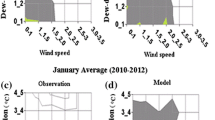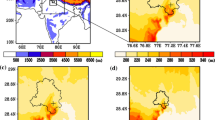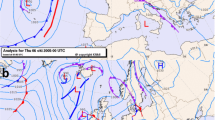Abstract
The numerical prediction of fog requires a very high vertical resolution of the atmosphere. Owing to a prohibitive computational effort of high resolution three dimensional models, operational fog forecast is usually done by means of one dimensional fog models. An important condition for a successful fog forecast with one dimensional models consists of the proper integration of observational data into the numerical simulations. The goal of the present study is to introduce new methods for the consideration of these data in the one dimensional radiation fog model PAFOG. First, it will be shown how PAFOG may be initialized with observed visibilities. Second, a nudging scheme will be presented for the inclusion of measured temperature and humidity profiles in the PAFOG simulations. The new features of PAFOG have been tested by comparing the model results with observations of the German Meteorological Service. A case study will be presented that reveals the importance of including local observations in the model calculations. Numerical results obtained with the modified PAFOG model show a distinct improvement of fog forecasts regarding the times of fog formation, dissipation as well as the vertical extent of the investigated fog events. However, model results also reveal that a further improvement of PAFOG might be possible if several empirical model parameters are optimized. This tuning can only be realized by comprehensive comparisons of model simulations with corresponding fog observations.












Similar content being viewed by others
References
Anthes, R.: 1974, Data assimilation and initialization of hurricane prediction models. Journal of the Atmospheric Sciences 31, 702–719.
Baldauf, M., K. Stephan, S. Klink, C. Schraff, A. Seifert, J. Förstner, T. Reinhardt, and C.-J. Alenz : 2006, The new very short range forecast model LMK for the convection-resolving scale. In: Second THORPEX International Science Symposium. Volume of extended abstracts, Part B. pp. 148–149.
Bergot, T., J. N. Carrer, and P. Bougeault: 2005, Improved Site-Specific Numerical Prediction of Fog and Low Clouds: A Feasibility Study. Weather and Forecasting 20, 627–646.
Bergot, T. and D. Guedalia: 1994, Numerical forecasting of radiation fog. Part I: Numerical model and sensitivity tests. Monthly Weather Review 122, 1218–1230.
Bott, A.: 1997, A numerical model of the cloud-topped planetary boundary-layer: Impact of aerosol particles on radiative forcing of stratiform clouds. Quarterly Journal of the Royal Meteorological Society 123, 631–656.
Bott, A., U. Sievers, and W. Zdunkowski: 1990, A radiation fog model with a detailed treatment of the interaction between radiative transfer and fog microphysics. Journal of Atmospheric Sciences 47, 2153–2166.
Bott, A. and T. Trautmann: 2002, PAFOG - a new efficient forecast model of radiation fog and low-level stratiform clouds. Atmospheric Research 64, 191–203.
Capon, R., Y. Tang, and P. Clark: 2007, A 3D high resolution model for local fog prediction. In: NetFAM/COST 722 workshop on cloudy boundary layer, Toulouse, France.
Cermak, J. and J. Bendix: 2007, ‘Dynamical nighttime fog/low stratus detection based on Meteosat SEVIRI data - A feasibility study. Journal of Applied Meteorology 164, 1179–1192.
Chaumerliac, N., E. Richard, and J.-P. Pinty: 1987, Sulfur scavenging in a mesoscale model with quasi-spectral microphysics: two-dimensional results for continental and maritime clouds Journal of Geophysical Research 92, 3114–3126.
Clark, P. and W. Hopwood: 2001, One-dimensional site-specific forecasting of radiation fog. Part I: Model formulation and idealised sensitivity studies. Meteorological Applications 8, 279–286.
Fu, Q.: 1991, Parameterisation of radiative processes in vertically non-homogeneous multiple scattering atmospheres. Ph.D. thesis, Department of Meteorology, The University of Utah.
Fu, Q. and K. Liou: 1992, On the correlated k-distribution method for radiative transfer in non-homogeneous atmospheres. Journal of Atmospheric Sciences 49, 2139–2156.
Guedalia, D. and T. Bergot: 1994, Numerical Forecasting of Radiation Fog. Part II: A Comparison of Model Simulation with Several Observed Fog Events. Monthly Weather Review 122, 1231–1246.
Gultepe, I. and J. Milbrandt: 2007, Microphysical observations and mesoscale model simulation of a warm fog case during FRAM project. Pure and Applied Geophysics, Special Issue on fog 164, 1161–1178.
Gultepe, I., M. Müller, and Z. Boybeyi: 2006, A new visibility parameterization for warm fog applications in numerical weather prediction models. Journal of Applied Meteorology 45, 1469–1480.
Gultepe, I., G. Pearson, J. Milbrandt, B. Hansen, S. Platnick, P. Taylor, M. Gordon, J. Oakley, and S. Cober: 2009, The fog remote sensing and modeling (FRAM) field project. Bulletin of the American Meteorological Society 90, 341–359.
Gultepe, I., R. Tardif, S. Michaelides, J. Cermak, A. Bott, J. Bendix, M. Müller, M. Pagowski, B. Hansen, G. Ellrod, W. Jacobs, G. Toth, and S. Cober: 2007, Fog research: A review of past achievements and future perspectives. Pure and Applied Geophysics 164, 1121–1159.
Jänicke, R.: 1993, Aerosol-Cloud-Climate Interactions, Chapt. Tropospheric Aerosols, pp. 1–31. Academic Press, San Diego.
Kalnay, E.: 2003, Atmospheric Modeling, Data Assimilation and Predictability. Cambridge University Press.
Koschmieder, H.: 1924, Theorie der horizontalen Sichtweite. Beitraege zur Physik der freien Atmosphaere 12, 33–35.
Kunkel, B.: 1984, Parameterization of droplet terminal velocity and extinction coefficient in fog models. Journal of Climate and Applied Meteorology 23, 34–41.
Loughlin, P., T. Trautmann, A. Bott, W. Panhans, and W. Zdunkowski: 1997, The effects of different radiation parametrizations on cloud evolution. Quarterly Journal of the Royal Meteorological Society 123, 1985–2007.
Masbou, M.: 2008, LM-PAFOG—a new three-dimensional fog forecast model with parametrised microphysics. Ph.D. thesis, Meteorological Institute, University of Bonn.
Mellor, G. and T. Yamada: 1974, A hierarchy of turbulence closure models for planetary boundary layers. Journal of Atmospheric Sciences 31, 1791–1806.
Mellor, G. and T. Yamada: 1982, Development of a turbulence closure model for geophysical fluid problems. Reviews of Geophysics 20, 851–875.
Müller, M., M. Masbou, A. Bott, and Z. Janjic: 2005, Fog prediction in a 3D model with parametrized microphysics. In: Proc. WWRP Int. Symp. on Nowcasting and Very Short-Range Forecasting, Vol. 6. pp. 6–26.
Pielke, R. A.: 1984, Mesoscale Meteorological Modeling. Academic Press, Orlando 612 pp.
Sakakibara, H.: 1979, A scheme for stable numerical computation of the condensation process with large time steps. Journal of the Meteorological Society of Japan 57, 349–353.
Shettle, E. and R. Fenn: 1979, Models for the aerosols of the lower atmosphere and the effects of humidity variations on their optical properties. Environmental Research Paper.
Siebert, J., A. Bott, and W. Zdunkowski: 1992a, Influence of a vegetation-soil model on the simulation of radiation fog. Beitraege zur Physik der Atmosphaere 65, 93–106.
Siebert, J., U. Sievers, and W. Zdunkowski: 1992b, A one-dimensional simulation of the interaction between land surface processes and the atmosphere. Boundary layer Meteorology 59, 1–34.
Stauffer, D. and N. Seaman: 1990, Use of 4-D data assimilation in a limited area mesoscale model. Part I: Experiments with synoptic scale data. Monthly Weather Review 118, 1250–1277.
Tardif, R. and R. Rasmussen: 2007, Event-based climatology and typology of fog in the New York City region. Journal of Applied Meteorology 46, 1141–1168.
Terradellas, E. and D. Cano: 2007, Implementation of a Single-Column Model for Fog and Low Cloud Forecasting at Central-Spanish Airports. Pure and Applied Geophysics 164, 1327–1345.
Twomey, S.: 1959, The nuclei of natural cloud formation Part II: The supersaturation in natural clouds and the variation of cloud droplet concentration. Geofisica pura e applicata 43, 243–249.
Unden, P., L. Rontu, H. Jaervinen, P. Lynch, J. Calvo, G. Cats, J. Cuxart, K. Eerola, C. Fortelius, J. Garcia-Moya, C. Jones, G. Lenderlink, A. McDonald, R. McGrath, B. Navascuez, N. Woetman Nielsen, V. Oedegaard, E. Rodriguez, M. Rummukainen, R. Room, K. Sattler, B. Hansen Sass, H. Savijaervi, B. Wichers Schreur, R. Sigg, H. The, and A. Tijm: 2002, ‘HIRLAM-5 Scientific Documentation’. Technical report, Swedish Meteorological and Hydrological Institute (SMHI).
Westcott, N. E.: 2007, Some Aspects of Dense Fog in the Midwestern United States. Weather and Forecasting 22, 457–465.
Yang, D., H. Ritchie, S. Desjardins, G. Pearson, A. MacAfee, and I. Gultepe: 2009, High Resolution GEM-LAM application in marine fog prediction: Evaluation and diagnosis. Weather and Forecasting 25, 727–748.
Zdunkowski, W., W.-G. Panhans, R. Welch, and G. Korb: 1982, A radiation scheme for circulation and climate models. Beitraege zur Physik der Atmosphaere 55, 215–238.
Acknowledgments
The iPort project is funded by the German Ministry for Economy and Technology. The authors wish to thank Michael Rohn, Wolfgang Raatz, Lucas Wenke, Björn-Rüdiger Beckmann and Peer Röhner from DWD for their cooperation in the iPort-VIS project. Wolfgang Adam from the Lindenberg observatory of the DWD is gratefully acknowledged for providing the data set of the investigated case study.
Author information
Authors and Affiliations
Corresponding author
Rights and permissions
About this article
Cite this article
Thoma, C., Schneider, W., Masbou, M. et al. Integration of Local Observations into the One Dimensional Fog Model PAFOG. Pure Appl. Geophys. 169, 881–893 (2012). https://doi.org/10.1007/s00024-011-0357-4
Received:
Revised:
Accepted:
Published:
Issue Date:
DOI: https://doi.org/10.1007/s00024-011-0357-4




